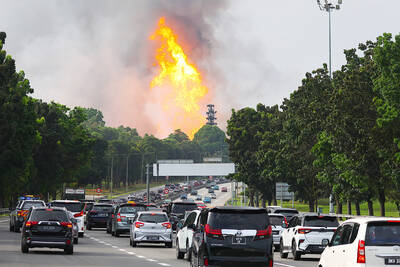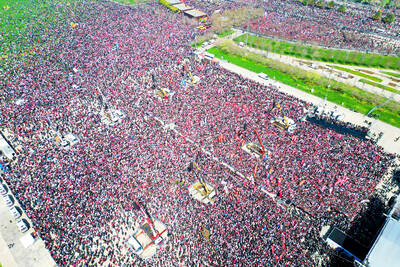Discord in Southeast Asia over how to deal with Beijing’s claims in the South China Sea comes as the region struggles to overcome competing national interests and form a EU-style economic community by 2015.
Political leaders and officials say the row may not directly affect plans by ASEAN for the economic integration of countries ranging from wealthy Singapore to impoverished Myanmar.
However, what does not help is China’s growing investment in the bloc’s poorer members, which critics say gives it influence that it has effectively used to block a unified ASEAN stance in the South China Sea dispute. The South China Sea, which stretches from China to Indonesia and from Vietnam to the Philippines, lies atop what are believed to be rich reserves of oil and gas.
“It’s not going to hold progress [on integration] hostage,” ASEAN Secretary-General Surin Pitsuwan told diplomats in Jakarta, referring to a recent meeting in Cambodia, where rifts over the South China Sea prevented the group’s foreign ministers from issuing a communique for the first time in its history. “It is an early warning sign ... this will not be the last.”
Southeast Asia is a popular destination for investors seeking returns that are drying up in Europe, still to recover in the US and slowing in the rest of Asia.
Estimated net flows into offshore ASEAN funds stood at US$1.4 billion this year through June, according to data reported until July 10. By comparison, China and India offshore funds saw net outflows worth US$1.6 billion and US$185 million respectively. Investors have high hopes for plans by the 10-member ASEAN for a single market and production base for a combined economy of US$2 trillion, with free movement of goods, services, investment and skilled labour among 600 million people.
While there is consensus in ASEAN for economic union, the group struggles with political differences ranging from a land border dispute between Thailand and Cambodia to a cultural spat between Malaysia and Indonesia. The most destructive is the inability to deal with claims by four of its members and China and Taiwan in the South China Sea.
Since only some elements of the economic plan will be in place by 2015, such as zero tariffs, more developed members may have to push on with integration in a two-tier model, just as the EU did, leaving the others at risk of missing out on regional investment.
ASEAN’s older and more developed members are Singapore, Malaysia, Thailand, the Philippines, Indonesia and Brunei. Vietnam, Laos, Cambodia and Myanmar joined later.
The two-tier model could leave fringe members further exposed to influence from China — and the US — as they seek influence through investment and diplomacy in a “Great Game” played out in the tropics.
China is already the top investor in Cambodia and Myanmar and is catching up with investment by Europe, Japan and the US in the region overall.
“The difference is that China is giving something that Cambodia needs, while ASEAN is promising something that is abstract,” said Aleksius Jemadu, dean of the school of political and social sciences at Pelita Harapan University in Jakarta.
“ASEAN countries will act based more on their domestic needs ... When this community is built we can’t expect them to be in unison, just like what happened to the South China Sea,” Jemadu said.
At the Phnom Penh meeting of foreign ministers, some diplomats said Cambodia blocked the South China Sea dispute being put on the agenda at China’s behest. Cambodian diplomats in turn accused the Philippines and Vietnam of trying to hijack the meeting.
China has maintained it wants to deal with the issue bilaterally.
The Philippines has said it deplored ASEAN’s failure to address the row and criticized Cambodia for its handling of the issue.
Cambodia had GDP per capita of US$900 last year and foreign direct investment (FDI) of US$800 million in 2010, according to World Bank figures. That compares to Singapore’s US$46,241 per capita and US$39 billion in FDI.
The China Daily has said Beijing’s investment in Cambodia from 1994 until last year was US$8.8 billion.
Even without the economic and political differences, a lack of capacity among some of ASEAN’s members is making it hard to implement economic agreements.
Completion of measures towards a single market in its 2010-2011 phase was only 49 percent overall, according to ASEAN’s latest scorecard, with reform lagging in food and agriculture.
“Early achievements were based on low hanging fruit ... The process of transposing regional commitments into national laws is the biggest [challenge],” said Subash Pillai, ASEAN’s director of market integration.
The Philippines struggles to send officials to meetings sometimes and can be slow making decisions, insiders say, and may even risk falling into the weaker group of Cambodia, Laos, Vietnam and Myanmar. These four are already being given more time to fully reduce tariffs.
“They might not be up to the same level,” Pillai said.
A recent visit to Myanmar’s central bank found just a few idle computers, a stark contrast to the soaring towers that control banks and policy in Singapore and Indonesia.
The bloc’s ASEAN Minus X mechanism allows “flexible” implementation of commitments, by enabling members to opt out of economic schemes if they are not ready.
This has already been used. Singapore and Laos are the only members pushing ahead with an agreement on education services. Six countries including Vietnam signed an agreement to link their stock markets by the end of last year, to spur electronic cross-border trading, but only Singapore and Malaysia are implementing it.
“You cannot expect all countries to be moving ahead at the same time. The ones lagging behind will suffer,” said another senior ASEAN official, who declined to be identified.
The South China Sea spat also shows the problems ASEAN has resolving major disputes. Unlike the EU, an inspiration if not a model, ASEAN lacks elected members of a central parliament, a powerful executive body or a regional court to make law and enforce its will.
Instead, it has the Jakarta-based ASEAN Secretariat, a body with little clout.
“Without a strong central mechanism it is very difficult to coordinate and survey all the issues that could become big issues,” Surin said.
The bloc will face further challenges as it tries to standardize customs procedures and open up protected industries such as financial services to competition from within. It has implemented free transfer of profits and dividends but needs to remove further barriers to intra-regional investment flows.
“They are behind schedule [on the economic community] and clearly not going to make it ... they are not going to see much action on services,” said Hal Hill, professor of Southeast Asian economies at the Australian National University.
And China’s expanding influence looms large.
“The Phnom Penh meetings in July were significant not just because China sought to divide ASEAN by leaning on Cambodia, but because China was happy to do so, so brazenly,” said Bryony Lau, a researcher on the South China Sea for the International Crisis Group think tank in Jakarta.

A fire caused by a burst gas pipe yesterday spread to several homes and sent a fireball soaring into the sky outside Malaysia’s largest city, injuring more than 100 people. The towering inferno near a gas station in Putra Heights outside Kuala Lumpur was visible for kilometers and lasted for several hours. It happened during a public holiday as Muslims, who are the majority in Malaysia, celebrate the second day of Eid al-Fitr. National oil company Petronas said the fire started at one of its gas pipelines at 8:10am and the affected pipeline was later isolated. Disaster management officials said shutting the

US Vice President J.D. Vance on Friday accused Denmark of not having done enough to protect Greenland, when he visited the strategically placed and resource-rich Danish territory coveted by US President Donald Trump. Vance made his comment during a trip to the Pituffik Space Base in northwestern Greenland, a visit viewed by Copenhagen and Nuuk as a provocation. “Our message to Denmark is very simple: You have not done a good job by the people of Greenland,” Vance told a news conference. “You have under-invested in the people of Greenland, and you have under-invested in the security architecture of this

UNREST: The authorities in Turkey arrested 13 Turkish journalists in five days, deported a BBC correspondent and on Thursday arrested a reporter from Sweden Waving flags and chanting slogans, many hundreds of thousands of anti-government demonstrators on Saturday rallied in Istanbul, Turkey, in defence of democracy after the arrest of Istanbul Mayor Ekrem Imamoglu which sparked Turkey’s worst street unrest in more than a decade. Under a cloudless blue sky, vast crowds gathered in Maltepe on the Asian side of Turkey’s biggest city on the eve of the Eid al-Fitr celebration which started yesterday, marking the end of Ramadan. Ozgur Ozel, chairman of the main opposition Republican People’s Party (CHP), which organized the rally, said there were 2.2 million people in the crowd, but

JOINT EFFORTS: The three countries have been strengthening an alliance and pressing efforts to bolster deterrence against Beijing’s assertiveness in the South China Sea The US, Japan and the Philippines on Friday staged joint naval drills to boost crisis readiness off a disputed South China Sea shoal as a Chinese military ship kept watch from a distance. The Chinese frigate attempted to get closer to the waters, where the warships and aircraft from the three allied countries were undertaking maneuvers off the Scarborough Shoal — also known as Huangyan Island (黃岩島) and claimed by Taiwan and China — in an unsettling moment but it was warned by a Philippine frigate by radio and kept away. “There was a time when they attempted to maneuver